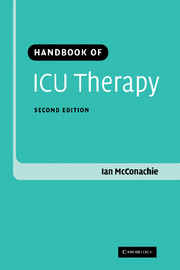Book contents
- Frontmatter
- Contents
- List of contributors
- Preface
- Part I Basic principles
- 1 Cardiac function, monitoring, oxygen transport
- 2 Shock
- 3 Oxygen therapy
- 4 Central venous access
- 5 Fluid therapy in ICU
- 6 Anaemia and blood transfusion
- 7 Nutrition
- 8 Non-invasive mechanical ventilation
- 9 Principles of IPPV
- 10 Modes of ventilation and ventilatory strategies
- 11 Weaning and tracheostomy
- 12 Vasoactive drugs
- 13 Infection and infection control
- 14 Sedation, analgesia and neuromuscular blockade
- 15 Continuous renal replacement therapy
- 16 Withholding and withdrawing therapy in the ICU
- Part II Specific problems
- Index
4 - Central venous access
Published online by Cambridge University Press: 24 August 2009
- Frontmatter
- Contents
- List of contributors
- Preface
- Part I Basic principles
- 1 Cardiac function, monitoring, oxygen transport
- 2 Shock
- 3 Oxygen therapy
- 4 Central venous access
- 5 Fluid therapy in ICU
- 6 Anaemia and blood transfusion
- 7 Nutrition
- 8 Non-invasive mechanical ventilation
- 9 Principles of IPPV
- 10 Modes of ventilation and ventilatory strategies
- 11 Weaning and tracheostomy
- 12 Vasoactive drugs
- 13 Infection and infection control
- 14 Sedation, analgesia and neuromuscular blockade
- 15 Continuous renal replacement therapy
- 16 Withholding and withdrawing therapy in the ICU
- Part II Specific problems
- Index
Summary
Over 200,000 Central venous catheters (CVC's) are inserted in the UK each year [1] and many of these are either inserted in, or cared for in the intensive care setting. Therefore a comprehensive knowledge of any complications and methods of minimising these complications are essential for the intensive care physician.
Indications
The indications are as follows:
haemodynamic monitoring,
intravenous infusion of fluids,
intravenous infusion of drugs (e.g. inotropes, antibiotics),
total parenteral nutrition (TPN),
renal replacement therapy,
intravenous access in patients with poor peripheral access (e.g. IV drug abusers).
Sites used for insertion
Sites used for central venous cannulation include:
internal jugular vein (IJV),
subclavian vein (SV),
femoral vein (FV),
external jugular vein,
axillary vein,
peripherally-inserted central catheter (PICC).
The first three of the above are the most commonly used, and this chapter will concentrate mainly on these. The fact that there is such a choice of sites suggests that there is not one site that is significantly better for CVC insertion than any other. Indeed each one has its own advantages and disadvantages, and choosing which site to use is also discussed in this chapter.
Insertion technique: landmark or ultrasound?
The standard technique for CVC placement is using the “landmark” method — the relationship of the chosen vein to known anatomical landmarks is used to guide the needle in the right direction.
- Type
- Chapter
- Information
- Handbook of ICU Therapy , pp. 39 - 51Publisher: Cambridge University PressPrint publication year: 2006



